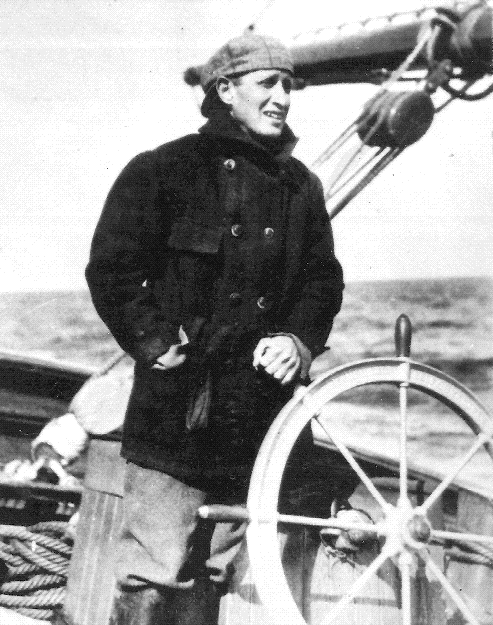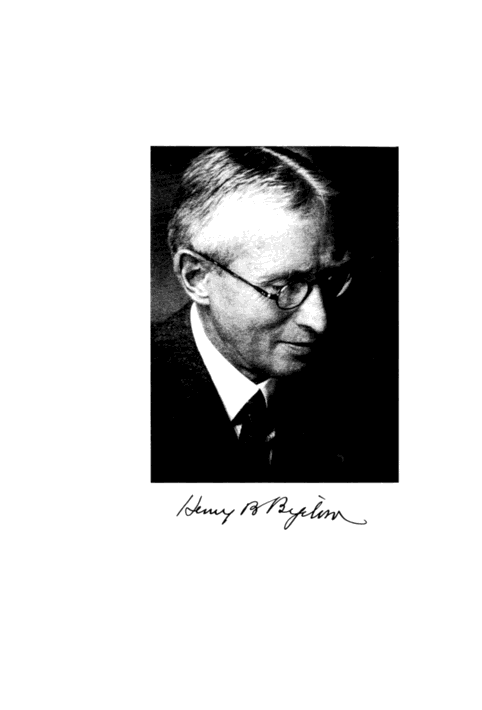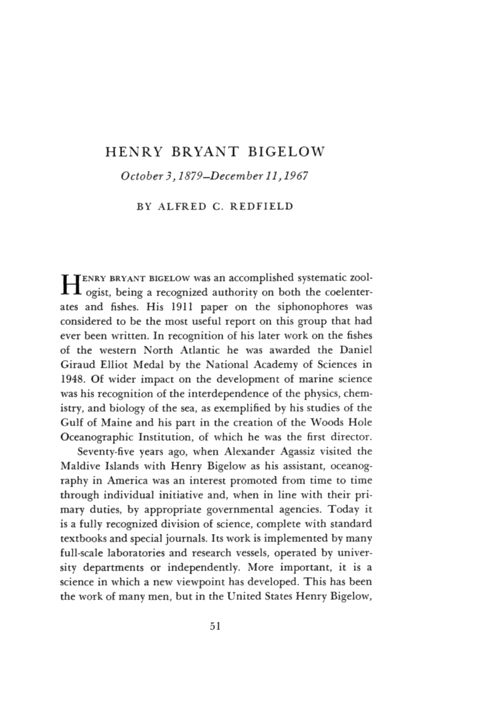
At the wheel of the Schooner Grampus, 1912

Children of Henry and Elizabeth (Shattuck) Bigelow: 4 children.
1555C.11521 Frederick Shattuck Bigelow, b 16 Mar 1915 Concord, MA; d 19 Feb 2002 Lebanon, NH; m 1950 Beverly Horner, in Milton, MA (she died in 1994); 4 children;
1555C.11522 Mary Cleveland, b 24 Jul
1909; d 27 Apr 2007 ; m Lamar Soutter (1909-1996); both buried
Mount Auburn Cemetery; Cambridge, Middlesex Co, MA.
1555C.11523 Elizabeth Perkins Bigelow, b 28 Jun 1907; d 14 Jan 1934 (aged 26); buried Mount Auburn Cemetery; Cambridge, Middlesex Co, MA.
1555C.11524 Henry Bryant Bigelow jr., b 18 Mar 1912; d 16 Sep 1931 (aged 19) Died on Mount Washington, NH; buried Mount Auburn Cemetery; Cambridge, Middlesex Co, M
Sources:
Bigelow Society,The Bigelow Family Genealogy, Vol II, pg
395;
Howe, Bigelow Family of America;
Sibley's Harvard Graduates;
Cambridge vital records;
correspondence between Bigelow Society historian/genealogist and
descendants.


Note2:
Subject: Henry Bryant Bigelow
Date: Sat, 25 Oct 2003 13:15:57 -0400
From: "Evans, Gael A." <gevans@WPI.EDU>
I was surprised not to find any info on H. B. Bigelow, the famous
scientist whom was professor of zoology at Harvard for
many, many years. He was a descendant of Horatio R. Bigelow and
Annie L. Smith. Perhaps, I am just missing something
on your site. It is a great site!
Dr. Bigelow married into the Shattuck family, who were prominent
members of the Boston medical community going way
back to the 1600s.
Gael Evans
From Bigelow
Laboratory
site:
Henry Bigelow was a pioneering
ocean
researcher whose extensive investigations in the early part of the
Twentieth
Century were later recognized as the foundation of modern
oceanography.
His expeditions in the Gulf of Maine, where he collected water
samples
and data on the phytoplankton, fish and hydrography, made this
region one
of the most thoroughly studied bodies of water, for its size, in
the world.
His work stressed the interdependence of biology, chemistry and
physical
science in studying the ocean. His three book-length monographs
are famous
for their clarity and exact scientific writing, and Fishes
of the
Gulf of Maine is a useful handbook for today's
scientists.
Bigelow's 1929 report to the National
Academy of Sciences led to establishment of the Woods Hole
Oceanographic Institution in 1930, of which he was the
founding director. In the report, Bigelow wrote of "our general
ignorance of the inter-relationships in the very complex chain of
events in the sea that govern the comparative success or failure
of its inhabitants in the struggle for life. Nothing in the sea
falls haphazard; if we cannot predict, it is because we do not
know the cause, or how the cause works."
Henry Bryant Bigelow grew up in
Boston, spent summers on Cape Cod and developed a life-long love
of the outdoors and nature. He was brought up in a well-to-do
family, attended Milton Academy and enjoyed several trips to
Europe with his family. Although not an athlete, he enjoyed
hunting, fishing and sailing. He entered Harvard in 1897,
admittedly did not enjoy college life and made few friends;
however, he excelled in natural history subjects and graduated cum
laude in 1901. While at Harvard, Bigelow made a most important
alliance with Professor Alexander Agassiz ,who was known
for his explorations in the Pacific Ocean. Although they did not
know each other well, Bigelow asked Agassiz to take him on his
next cruise. To his delight, Agassiz agreed, and in the winter of
1901, Bigelow served as assistant on an expedition to the Maldive
Islands in the Indian Ocean. Bigelow traveled by land and sea to
many exotic places in the course of
the trip: to Naples, Ceylon, Algiers, Batavia, Singapore, Hong
Kong and
Tokyo, returning to the States through San Francisco. Upon his
return to
Cambridge, he was assigned to study the medusae collected on the
voyage;
these furnished material for his doctoral research (1906). Three
years later,
he was again Professor Agassiz's assistant on the Albatross
Expedition to
the Eastern Tropical Pacific. A third trip with Agassiz took place
in 1907,
shortly after his marriage to Elizabeth Shattuck. She eagerly
joined this
voyage to the West Indies, and during their sixty years together,
Elizabeth
accompanied Henry on many of his research expeditions. After
joining the
staff of Harvard's Museum of Comparative Zoology in 1905, Bigelow
published
papers on various biological subjects. The majority of these were
on coelenterates
(which includes the jellyfish, sea anemones and corals), and many
publications
were illustrated with Bigelow's own drawings and photographs.
Bigelow joined
the teaching faculty of Harvard in 1921 and became an
internationally known
expert on the coelenterates and on fishes, especially sharks and
rays. Bigelow
received his Ph.D. from Harvard in 1906 and served on the faculty
for 62
years.
Between 1901-1968, 110 papers were
published with Bigelow as the major author. He was distinguished
as having been on the staff of Harvard longer than any other
person in the history of the University. In fact, in 1960, Bigelow
joked to a member of the Harvard Board that he
thought the University owed him a bottle of bourbon whiskey in
appreciation of his service. A short while later he was surprised
by a delivery, "with the compliments of the President and
Fellows." His autobiography notes that "no one else has ever been
presented with a bottle of whiskey by Harvard
University."
The famous photograph of Bigelow at the wheel of the schooner Grampus was taken in 1912. It is notable for marking a second major phase of Bigelow's scientific career when he began studies of the Gulf of Maine. These voyages were jointly sponsored by the Museum of Comparative Zoology at Harvard and the U.S. Bureau of Fisheries. Over twelve years, Bigelow studied this region extensively, mostly working alone, and published three monographs on the physical oceanography, plankton, and fishes, which, taken together, gave the most complete account of the oceanography of the Gulf of Maine and set a new standard for modern work in marine science.
From 1912 to 1928, 350 stations were occupied in the Gulf of
Maine region where serial measurements of temperature (and often
salinity) were obtained; 10,116 tow net hauls were made; one
thousand drift bottles were set and so many recovered that he
could establish the prevailing non-tidal current system of the
Gulf and Georges Bank. As a result of these studies, Bigelow
wrote, "it is generally conceded that, oceanographically, the Gulf
of Maine is better known than is any other comparable area of the
ocean..." Bigelow's findings are still referred to frequently in
scientific discussions about the Gulf of Maine. "We might call
Bigelow one of the founders of the new oceanography,
that is oceanography with an ecological aim, so that instead of
the mere
description of what there was in the sea, there should be an
explanation
of the inter-connections based on full knowledge and the
applications of
other branches of science," wrote Michael Graham in Deep Sea
Research, in
April 1968. In 1927 Bigelow began a long-term collaboration with
William C.
Schroeder, in publishing more than forty papers in ichthyology -
mainly the
sharks and batoid fishes (sawfishes, skates and rays). Together
they published
some 1100 pages in volumes of Fishes of the Western North Atlantic
between
1948 - 1965. In 1930 the Rockefeller Foundation gave $2.5 million
to establish
the oceanographic institution at Woods Hole and also paid for the
construction
of a 140 ft. ship to be used as a sea-going
laboratory. At that time, Dr. Bigelow presented his case for the
new
science of oceanography - a departure from the fact-finding
expeditions
of the past. He stated, "Oceanography would die, but for the
development
of a new point of view - the idea that what is really interesting
in sea
science is the fitting of the facts together....the time is ripe
for a systematic
attempt to lift the veil that obscures any real understanding of
the cycle
of events that takes place in the sea. It is this new point of
view that
is responsible for our new oceanographic institution." The July
1968 issue
of Oceanus, published by the Woods Hole Oceanographic Institution,
was
dedicated in memory of Henry Bigelow and contains tributes and
stories about
his life and
research from friends and colleagues. Paul M. Fye, then WHOI
Director, wrote:
In April 1927, the President of the National Academy of Sciences,Professor A. A. Michelson, appointed a committee with Frank R. Lillie as Chairman, to consider the share of the United States of America in a world-wide program of oceanographic research and report to the Academy. Subsequently, Dr. Bigelow was invited to make investigationsand prepare a report. The report led the Academy to recommend theestablishment of a well-equipped oceanographic institution on the eastcoast. The result was t hat our Institution was established almost fullblown in the course of a year, with Dr. Bigelow as director.
The report to the Academy was also published in Science magazine in 1930 and contained Bigelow's argument that a new oceanographic institution was necessary based on a fundamentally new way of conducting science. His definition of oceanography was visionary:
"Oceanography has been aptly defined as the study of the world belowthe surface of the sea; it should include the contact zone between the sea and atmosphere. According to present-day acceptance it has to do with all the characteristics of the bottom and margins of the sea, of the sea water, and of the inhabitants of the latter. Thus widely combining geophysics, geochemistry and biology, it is inclusive, as is, of course, characteristic of any 'young' science: and modern oceanography is in its youth. But in this case it is not so much immaturity that is responsible for the fact that these several sub-sciences are still grouped together, but rather the realization that the physics, chemistry, and biology of the sea water are not only important per se, but that in most of the basic problems of the sea all three of these subdivisions have a part. And with every advance in our knowledge of the sea making this interdependence more and more apparent, it is not likely that we shall soon see any general abandonment of this concept of oceanography as a mother science, the branches of which, though necessarily attacked by different disciplines, are intertwined too closely to be torn apart. Every ocean biologist should, therefore, be grounded in the principles of geophysics and geochemistry; every chemical or physical oceanographer in some of the oceanic aspects of biology."
Before the outbreak of World War II, Bigelow directed the attention of the researchers at Woods Hole to the plankton-rich waters of Georges Bank. Aboard the Institution's research vessel Atlantis, Bigelow and others studied the biology and chemistry of this region. Bigelow's early surveys showed that Georges Bank had longer seasons of phytoplankton production than the open Gulf of Maine. The area was commercially important for its haddock fishery, so the scientists set out to find what conditions provided such rich breeding grounds. For a man of the sea, it is interesting that Bigelow spent his leisure time hunting in the woods of Canada, Newfoundland and Nova Scotia. "In 1909," he wrote, "we built a house in Concord, by the Sudbury River, and have lived there ever since, moving to Cohasset, Duxbury, or Mount Desert in the summer. Professional activities have been engrossing, but never enough so to prevent occasional fishing and shooting trips. Wild fowling and trout fishing are my most absorbing pastimes." His life story involves many accounts of his adventures traveling, literally around the world, visiting out of the way places and always involving an adventure of some sort. His wife accompanied him on many camping and hunting trips by canoe and on horseback. The family traveled extensively, and he wrote about visiting European countries and of climbing expeditions in the Canadian Rockies and Swiss Alps. Into his eighties, he continued to travel and visited rain forests, jungles, and cattle ranches; his curiosity and interest in nature lasted for his lifetime For the Harvard Class of 1901 50th reunion publication, Bigelow wrote: "On December 31, 1939, I retired as Director of the Woods Hole Oceanographic Institution, but served as President of the Trustees until August 10, 1950, when I was made Chairman of the Board. I continued as Professor of Zoology and Alexander Agassiz Professor at Harvard, and as Curator and Research Oceanographer in the Museum of Comparative Zoology until June 30, 1950, when I was retired as Professor Emeritus. I still serve on the faculty of the Museum. My hobbies continue as before, gardening, woods work, fishing, skiing and outdoor life in general." He was an active skier at age 85! At that age, he writes of recent projects - writing a key for the identification of all the families of living fishes, writing a history of the Museum of Comparative Zoology (1911-1961), and writing a general natural history of the living fishes of the world. Bigelow received many honors and accolades during his lifetime: the Agassiz Medal of the National Academy of Sciences, Bowie Medal of the American Geophysical Union, Johannes Schmidt Medal of Denmark, Monaco Medal of the Institute Oceanographique in Paris , Elliot Medal of the National Academy of Sciences, and honorary degrees from Harvard, Yale and the University of Oslo. He was the first recipient of the Henry Bryant Bigelow Medal for Oceanography, established in his honor in 1966 by the trustees of the Woods Hole Oceanographic Institution. In 1970, the US Department of Interior gave the name Bigelow Bight to the large open bay in the Gulf of Maine between Cape Ann and Cape Small. Today, a large central laboratory building on the campus of the Woods Hole Oceanographic Institution bears his name, as does the Bigelow Laboratory for Ocean Sciences, a marine research institution founded in 1974 and located in West Boothbay Harbor, Maine.
Bibliography:
Bigelow, Henry B., Oceanography, its Scope, Problems and Economic
Importance, Houghton Mifflin, 1931. "Memories of a Long and Active
Life", The Cosmos Press, Cambridge,1964.
Graham, Michael, Deep Sea Research, Vol.15, No.2, April 1968, The Pergamon Press. Harvard College Library Clipping Sheet (Boston Globe, Boston Herald). Harvard University Gazette, Dec. 7, 1968. Harvard College Class of 1901 25th Anniversary Report. Harvard College Class of 1901 50th Anniversary Report.
Logan, Jennifer, "The Man Who Knew the Sea," Island Journal, Vol. IV, 1987.
Mills, Eric L., Biological Oceanography - An Early History, 1870-1960, Cornell University Press, 1989. Oceanus, Vol.XIV, No.2, July 1968, Woods Hole Oceanographic Institution.
Dobbs, David, Harvard Magazine Jan-Feb 1999; "Vita, Henry Bryant
Bigelow". see vita.htm

